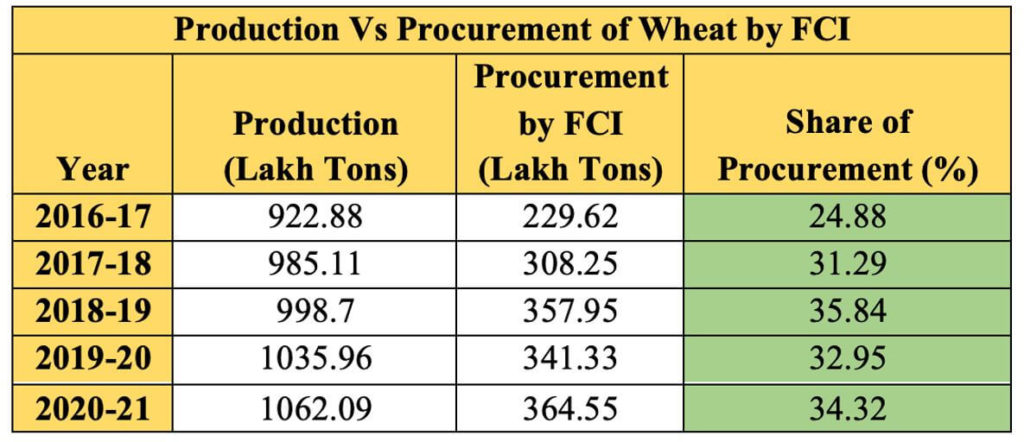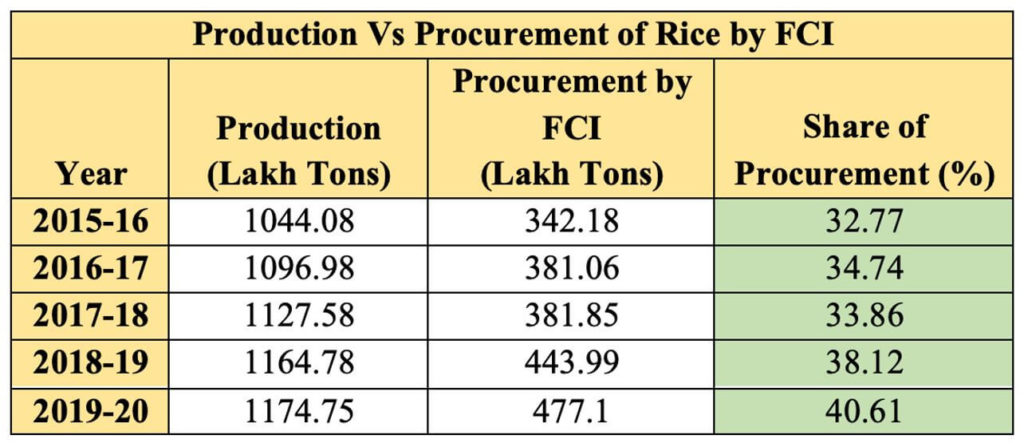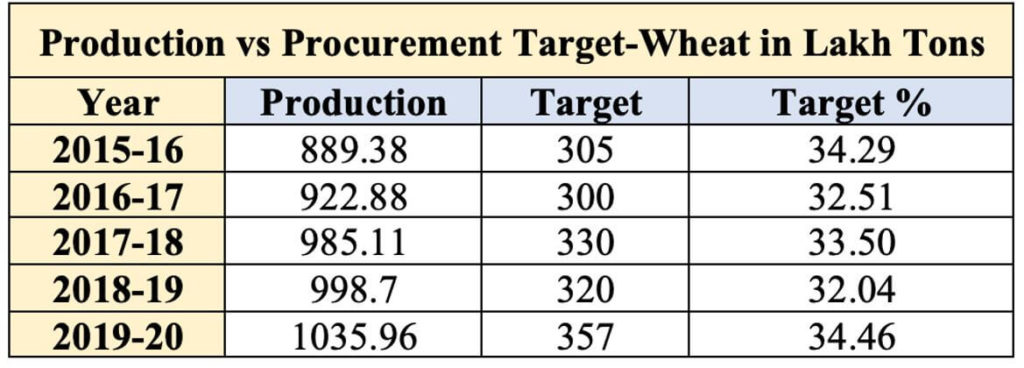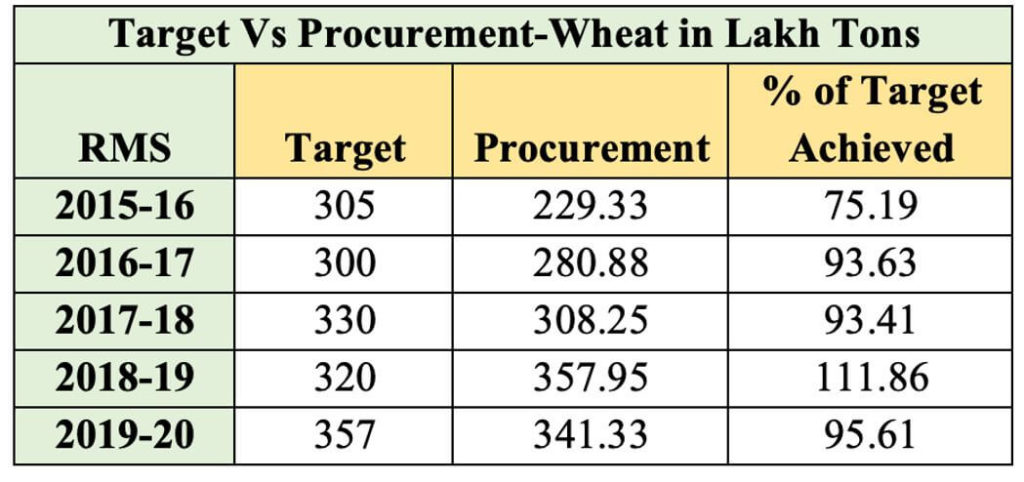In part-1 of this series, we looked at FCI’s food grain procurement numbers. In this concluding piece, we look at FCI’s procurement numbers compared to the overall food grain production in the country.
In the Part-I of this series on analysis of FCI’s food grain procurement, we looked at FCI procurement system along with volume of procurement by FCI & state agencies for Paddy & Wheat. In this story we take delve further into FCI’s procurement of food grains and how does it compare with overall production of food grains in the country.
Just over 1/3rd of Rice & Wheat produced in the country is procured by FCI
Apart from procuring food grains to ensure food security, another key objective of FCI is to provide price support to the farmers. As discussed in earlier stories, Minimum Support Price (MSP) is set by the government to ensure the farmers get a minimum price on selling their produce without being exploited.
FCI’s procurement policy states that procurement at MSP is open ended i.e. whatever produce is offered by the farmers (provided it is within the stipulated timelines and meets quality standards) is purchased at MSP by government agencies.

However, the procurement numbers for Rice and Wheat over the last five years indicate that the share of procurement is only around 1/3rd of the total produce.
In 2016-17, the total production of Wheat was 922.88 Lakh Tons (LT) of which 22.62 LT was procured i.e. 24.88% . The volume procured and the share of procurement registered a sharp increase the next year (2017-18), with the trend continuing in the subsequent year. A dip in 2019-20 was followed by an increase in the volume and share of procurement in the current Rabi Market Season (RMS 2020-21).
For RMS 2020-21, 364.55 LT of wheat was procured out of 1062.09 LT produced i.e. 34.32%.
It needs to be noted that while the trend of procurement varied over the five-year period, the production has consistently increased year on year.

Meanwhile, the share of procurement of Rice (paddy) by FCI & assigned State agencies has increased from 32.77% to 40.61% during the five-year period 2015-2020.
For the Marketing Season 2015-16, 342.18 LT of rice was procured out of 1044.08 LT produced i.e. 32.77%. The volume of rice produced also increased consistently every year. Apart from a dip in 2017-18, even the share of procurement out of the total production has increased yearly.

Procurement targets set by the government are significantly lower than the production
Prior to the start of the yearly Marketing Seasons (Kharif & Rabi), the Government of India sets the procurement target for the season. These targets are set to ensure that the government would be able to procure food grains needed for food security. The procurement targets set for both Rice as well as Wheat are only around 1/3rd of the total production.
Through the five-year period of 2015-20, the procurement target for wheat set by the government increased from 305 LT to 357 LT. During the period, production increased from 889.38 MT to 1035.96 MT. During these 5 years, the greatest estimated target compared to production was in 2019-20 with 34.46%.

Similarly, even in the case of Rice, the targets set by the government hovered between 30-40% of the production in the respective years. The procurement target increased year on year except for 2019-20, where in it decreased to 416 LT compared to 448 LT in the previous year. Similarly, the target fell to 35.41% of the production compared to 38.5% the previous year.

It is evident that the estimated targets are substantially lower compared to the production. The procurement targets are primarily to ensure that the food grains required for food security initiatives are procured. However, as indicated earlier, one of the main objectives of FCI is also to provide an option for the farmers to get right price for the produce and not get exploited.
With the yearly targets not going beyond 1/3rd of the production, 2/3rd of the produce is left to the mercy of outside buyers. As a result, though MSP is notified by the government, it is actually helping only 1/3rd of the farmers.
Actual Procurement is still less than the target fixed at the beginning of the year
The trends of last few years suggest that the actual volume procured is less than the target fixed for most of the marketing seasons.
Wheat is procured in the Rabi Marketing Season (RMS). During the five year period of 2015-20, with the exception of 2018-19, the procurement of Wheat FCI has fallen short of the set target every time. However, the situation has improved over the years. In 2015-16, only 75.19% of the target was procured. This has improved in the subsequent years.

In recent years, FCI has managed procure Rice as per the determined targets over two seasons. Data indicates that every year, there is a shortfall in procurement target in every Kharif season which is compensated by the procurement in the Rabi season. This makes up for the shortfall. Hence the procurement of Rice during the last 5 years

Government has to take measures to ensure price security to the entire produce
The shortfall in actual procurement compared to the targets set by the government indicates that FCI is not able to even procure the 1/3rd of the total produce. This could be because of multiple factors like lack of awareness, lack of facilities and other conditions for procurement.
The data does indicate that the situation has improved over the last few years, which could be due to the efforts made in increasing the number of procurement centres and making them more accessible.
However, this improvement is not even across the states. In case of Wheat, while Punjab and Haryana exceed the targets, other states like U.P, Rajasthan, Bihar, Gujarat and Madhya Pradesh have consistently not met their state level procurement targets.
In case of Rice, A.P and Telangana are among the major states whose short fall during Kharif results in the procurement targets not being met during that season, which is later covered by the procurement during Rabi.
There is a need to understand the state level differences and challenges in procuring the food grains and address them accordingly to ensure that at least the targets set for procurement are met.
Apart from this, the question of why the government does not increase its procurement target also remains. The challenge in selling the food grains after procurement is cited as a reason for conservative procurement targets despite higher production year on year.
At the end of the day, the procurement targets and their achievement do not comply with the open policy of FCI to buy whatever produce is brought in by the farmers and to provide them with price security.
Featured Image: FCI’s procurement numbers


